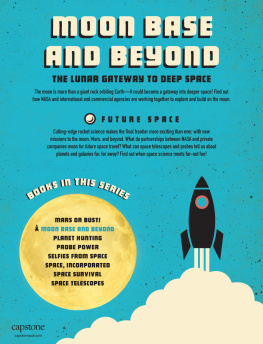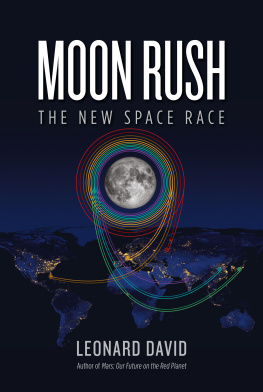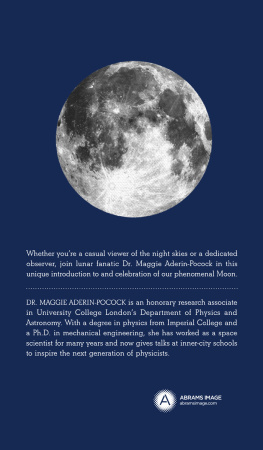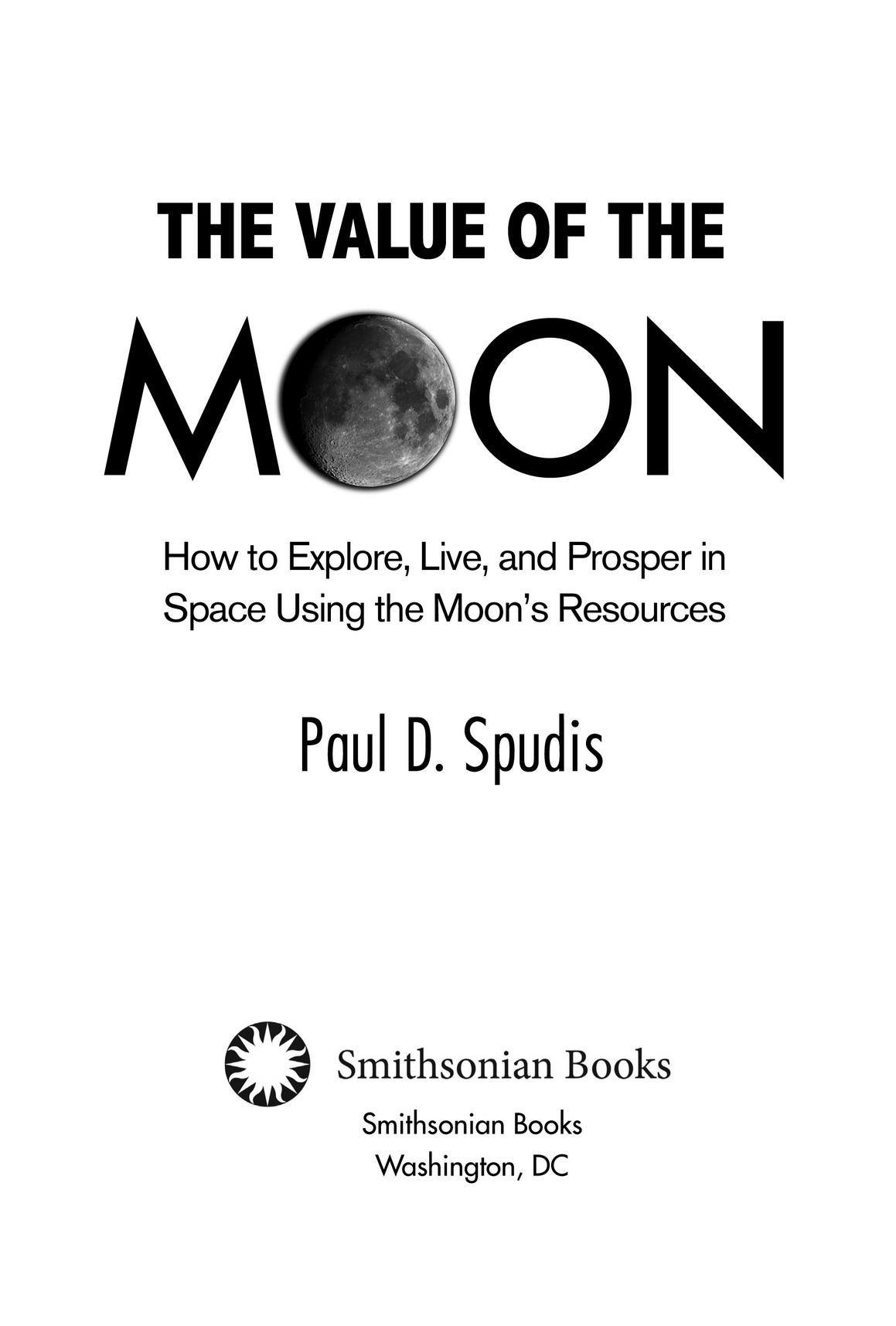2016 by Paul D. Spudis
All rights reserved. No part of this publication may be reproduced or transmitted in any form or by any means, electronic or mechanical, including photocopying, recording, or information storage or retrieval system, without permission in writing from the publishers.
This book may be purchased for educational, business, or sales promotional use. For information, please write: Special Markets Department, Smithsonian Books, P. O. Box 37012, MRC 513, Washington, DC 20013
Published by Smithsonian Books
Director: Carolyn Gleason
Production Editor: Christina Wiginton
Editorial Assistant: Jaime Schwender
Edited by Gregory McNamee
Designed by Brian Barth
Library of Congress Cataloging-in-Publication Data
Names: Spudis, Paul D., author.
Title: The value of the Moon : how to explore, live, and prosper in space using the Moons resources / Paul D. Spudis.
Identifiers: LCCN 2015033833| ISBN 9781588345035 | ISBN 1588345033
Subjects: LCSH: MoonExploration. | Outer space-Exploration. | Space flight. | Space industrialization.
Classification: LCC QB582.5 .S68 2016 | DDC 333.9/4-dc23 LC record available at http://lccn.loc.gov/2015033833
eBook ISBN: 9781588345042
For permission to reproduce illustrations appearing in this book, please correspond directly with the owners of the works, as seen . Smithsonian Books does not retain reproduction rights for these images individually, or maintain a file of addresses for sources.
www.SmithsonianBooks.com
v3.1
CONTENTS
PREFACE
T wenty years ago, I wrote The Once and Future Moon (Smithsonian Institution Press, 1996). That book described the field of lunar science for the interested nontechnical reader and explained what we had learned about the processes and history of the Moon from robotic and human missions. We were acquiring some tantalizing hints that the Moon was useful that it contained the material and energy resources necessary for a sustained human presence there. In the decades since then, exploration by robotic spacecraft has shown us more about the nature of these resources, confirming that the Moon is a more compelling destination than we had previously thought.
Regrettably, strategic confusion currently abounds in the American civil space program. Despite the hype and disprovable propaganda that we are preparing to conduct human missions to Mars, such an effort is far away technically, politically, and especially fiscally. A program to extend human reach beyond low Earth orbit (LEO) was arbitrarily terminated in 2010, and no rational program was offered by the administration as a replacement. Into this leadership vacuum, Congress stepped forward with a makeshift program to build a heavy lift launch vehicle (the Space Launch System) along with a human spacecraft designed for missions beyond LEO. No mission for these two items has been articulated. We will soon have some nice hardware, but no place to go.
In part, this policy chaos resulted from a misguided attempt to re-create the Apollo program. Apollo, now almost a half-century in the past, was the national effort that sent humans to the Moon. Contrary to the belief of many, the Apollo program was not about space explorationit was about beating the Soviet Union to the Moon by landing a man there first. The entire Apollo program was a Cold War battle, and the United States won. Afterward, we stopped going to the Moon. The wartime setting of Apollo dictated that it be conducted along the lines of a wartime program: with urgency, marshalling the best technology and industrial capacity we could muster, and with cost as a secondary consideration.
Since then, we have repeatedly failed to achieve sustainable space exploration beyond LEO by trying to shoehorn it into the Apollo template. After landing American astronauts on the Moon in a highly visible and successful manner, perhaps it was natural to assume that this approach should be the configuration for future space endeavors. But after continually trying to re-create the Apollo experience by focusing on a similar human mission to Mars, with all pieces launched entirely from the Earth, we are little closer to that goal today than we were fifty years ago. The Apollo template, applied to the even greater technical challenge of a Mars mission, is enormously difficult and thus, enormously expensive, requiring tens to hundreds of billions of dollars to conduct a single mission.
A slower but affordable approach to the problem of a human Mars mission would be to gradually and incrementally increase the range of spaceflight. To do this, we would need several technical developments, including reusable vehicles based in space, staging nodes at strategic space locations, and the ability to provision ourselves for the trip from non-Earth resources, especially with high-mass, low-information density items, such as life-support consumables and rocket propellant. To our great good fortune, nature has provided us with a readily available source for this materielthe Moon.
We can use the Moon to create new spaceflight capability. Water ice, the most useful material in space, occurs in abundance at the poles of the Moon. We can access and extract these valuable deposits because the poles also possess areas where we can generate electrical power nearly continuously. The polar oases of the lunar desert allow us to live on the Moon and learn how to use off-Earth material and energy resources. This effort will create a new paradigm of spaceflight: to use what is available in space instead of launching it all from the deepest gravity well in the inner solar system, the Earths surface. Such a development will revolutionize space travel.
Of critical importance to achieving this revolution is working out how to affordably establish a presence on the Moon. We have limited time and money to spend on space. I believe that there is a path to the Moon, one that accommodates the needs of federal, international, and commercial interests, a visionary scheme that will open up the solar system to economic development.
Modern technical civilization depends on a variety of assets in space. These machines monitor our weather and environment, provide instant global communications, permit precision navigation anywhere in the world, and secure our nation and the world with strategic surveillance. Satellites are vulnerable, and a national presence in cislunar spacethe space between Earth and the Moonis essential to guarantee our continued and uninterrupted access to these assets. A robust presence by the United States in cislunar space is necessary to assure the future emergence of free markets and to promote the growth of a pluralistic, political system on the new frontier.
This book tells the story of how we once went to the Moon, what we found as a result, our various efforts to return there, and especially why and how we should go back. We go to the Moon to create new capabilities. It is the next logical step in space beyond LEO.
I thank my colleagues who critically read and reviewed all or parts of the manuscript: Sam Lawrence (Arizona State University), John Greuner (NASAJohnson Space Center), Jack Frassanito (Frassanito and Associates, Inc.), Tony Lavoie (NASAMarshall Space Flight Center), and Ben Bussey (Johns Hopkins University Applied Physics Laboratory, currently detailed to NASA Headquarters). Some figures were provided by Dennis Wingo (Skycorp, Inc.), Mark Robinson (Arizona State University), and Jack Frassanito. As always, my wonderful wife, Anne, is my most insightful critic, merciless editor, and best friend; I especially thank her for editing multiple versions of this manuscript and for general inspiration.








